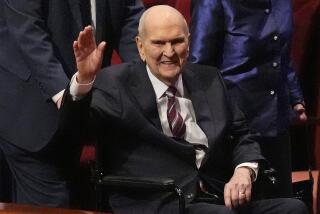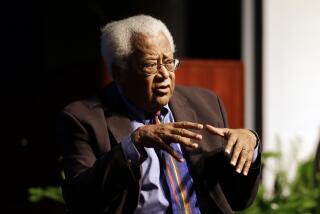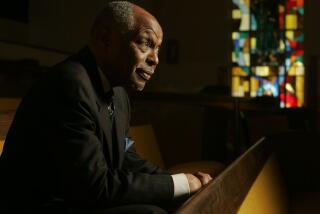He led Mormons’ rapid growth
Gordon B. Hinckley, the elderly but indefatigable Mormon leader who guided the Church of Jesus Christ of Latter-day Saints into the 21st century by building more temples, traveling more miles and moving Mormonism closer to the religious mainstream than any of his predecessors, died Sunday. He was 97.
The cause of death was not announced. Hinckley was hospitalized in January 2006, reportedly for the removal of a cancerous growth in his large intestine. According to a church statement, he died surrounded by his family.
Though he became the Mormons’ 15th president and prophet at age 84, Hinckley’s energy, style and longevity, which drew comparisons to Pope John Paul II, allowed him to engage millions throughout the world and provided the church a media-friendly face.
“On the basis of sheer numbers of members, Hinckley’s leadership will be marked by the church’s move from the margins, especially in the U.S., to the center, if not the mainstream,” said Dr. Jan Shipps, a professor emeritus at Indiana University-Purdue University Indianapolis and one of the nation’s leading scholars on Mormonism.
According to Mormon doctrine, the church’s leader is a “prophet, seer and revelator” able to receive divine revelations. The prophet is assisted by two counselors and, on the next step down in the hierarchy, 12 apostles, also considered prophets.
Upon the death of the president, the apostle with the longest length of service -- in this case, 80-year-old Thomas S. Monson -- ascends to the top post. Monson, a former newspaper executive with a fondness for storytelling, will run his presidency in a manner similar to Hinckley, several observers said.
During Hinckley’s more than 12-year presidency, church membership, fueled by 56,000 young missionaries, swelled by nearly 37% to 12.3 million people, according to church figures.
“People are looking for stability in a shaky world,” Hinckley told The Times some years ago. “They want something they can get hold of that’s firm and sure and an anchor in the midst of all of this instability in which they’re living. I think we offer that.”
The religion of Romney
Interest in the church also was heightened in the last year by the candidacy of former Massachusetts Gov. Mitt Romney, a Mormon, for the Republican presidential nomination. There was no immediate comment late Sunday from Romney’s camp on Hinckley’s death.
Latter-day Saints believe that their founder, Joseph Smith, received a divine revelation that he published in 1830 as the Book of Mormon. The scriptures include instructions from Jesus, who Mormons believed visited America after his resurrection, about how to restore the fallen Christian church.
Because of this text, Mormons believe that they are the one true church and the rest of Christianity is in a state of apostasy -- a belief downplayed by Hinckley in his public appearances.
To keep up with the church’s growth, Hinckley approved the construction, on average, of about 400 building projects a year worldwide. Most visible were the 75 temples -- each capped by a golden statue of a trumpet-blowing angel -- on six continents that opened during his presidency, including ones in Newport Beach and Redlands. The temples represent a 166% increase in the number built before Hinckley’s leadership.
His largest construction project -- the church’s Conference Center in Salt Lake City -- was dedicated in 2000. The 1.2-million-square-foot granite building seats 21,000 and has a broadcast center that can translate messages into 60 languages. The center’s black walnut altar was crafted from a tree in Hinckley’s backyard.
Though Salt Lake City is the Mormon version of the Vatican, Hinckley often said he would rather be out among the faithful in the world. At 95, for instance, he traveled more than 35,000 miles visiting countries including Russia, India, Kenya and France.
Public relations pro
In top health for his age for most of his presidency, Hinckley restored vibrancy to the Mormon leadership position, an office often hobbled by the debilitating illnesses of its geriatric presidents.
In fact, observers said that Hinckley, a top aide to his three sickly predecessors, in reality served as the faith’s de facto leader for 25 years.
Hinckley also was known as a brilliant public relations man, able to sooth the public’s fears about Mormonism without alienating the faithful and oftentimes winning over a skeptical media.
“His ability to stay on message may have surpassed President George W. Bush’s ability to make the press see things his way,” Shipps said. “Hinckley worked tirelessly to tell the world that the Saints were ‘not weird,’ but he did it without taking from the Saints their distinctive identity.”
Hinckley was born June 23, 1910, in Salt Lake City. His grandfather knew Mormon founder Joseph Smith and traveled to Utah with the faithful in the 19th century. Another of Hinckley’s ancestors came to America on the Mayflower.
Hinckley was raised in and around Salt Lake City, his family dividing its time between city and farm living.
In 1932, Hinckley graduated from the University of Utah and planned to get a master’s degree in journalism at Columbia University in New York. But his education was interrupted when he was called by the church to serve a two-year mission in England. He spent time preaching from a portable stage in London’s Hyde Park. When he returned to the States, Hinckley worked at the church’s headquarters in Salt Lake City, landing what at the time was a rare paid church job.
Two years later, with $150 saved, he wed his longtime sweetheart, Marjorie Pay. The marriage lasted 67 years until her death in 2004.. The couple had five children.
Hinckley climbed rapidly through the church hierarchy, working in a variety of positions, including head of the missionary program and founder of the church’s public affairs office.
In 1961, he was appointed to the Quorum of Twelve Apostles, a group that answers only to the president and his two counselors known collectively as the First Presidency. As an apostle, Hinckley was in charge of church affairs in Asia, Europe and South America.
Twenty years later, Hinckley ascended to the First Presidency, where he served as a counselor to three presidents -- Spencer W. Kimball, Ezra Taft Benson and Howard William Hunter -- whose tenures were marked by illness and frailty.
Hinckley was involved in most of the major decisions that have shaped Mormonism for more than three decades. On June 1, 1978, he was among the small group of church leaders gathered together when then-President Kimball received what Mormons consider a revelation that the church could drop its ban on allowing blacks into its priesthood.
In a high-profile controversy, Hinckley and other leaders in 1993 approved the excommunication of five prominent church members and severe discipline for another who publicly questioned portions of Mormon history and the legitimacy of an all-male priesthood, among other issues.
“Every individual in the church is free to think as he pleases,” Hinckley told the New York Times shortly after the decision. “But when an individual speaks openly and actively and takes measures to enlist others in opposition to the church . . . we feel there is cause for action.”
Hinckley began his presidency in 1995 by holding the first news conference by a prophet in 21 years. It signaled that a relatively spry 84-year-old was now in command of church affairs, along with a new openness that continued throughout Hinckley’s tenure.
Into high tech
Under Hinckley, the church embraced modern technology, including satellite television, an extensive multimedia website and the posting of genealogy databases on the Internet for the general public.
Hinckley appeared regularly on television, including guest spots on CNN’s “Larry King Live.”
Hinckley often spoke about the need for historically insular and persecuted Mormons to reach in love to people outside their faith.
“I’d like to speak to the whole world and declare the goodness of this church and the strength of its programs and the desire of its leaders to cultivate peace and goodwill and harmony and good relationships among the diverse peoples of the world,” he once said at a news conference.
He would often joke about his old age, saying that he didn’t even buy green bananas anymore.
In a 2005 meeting with reporters on the 10th anniversary of his presidency, Hinckley said he wasn’t concerned about his legacy.
“We just do our very best today,” he said, “and leave the rest for whatever happens.”
Information on funeral services was not immediately available.
--
More to Read
Sign up for Essential California
The most important California stories and recommendations in your inbox every morning.
You may occasionally receive promotional content from the Los Angeles Times.










